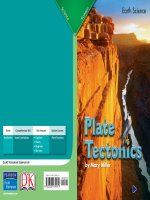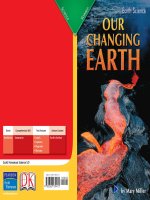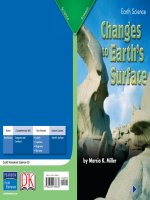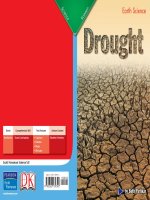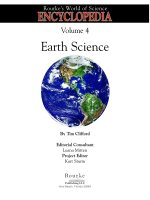4 10 resources (earth science)
Bạn đang xem bản rút gọn của tài liệu. Xem và tải ngay bản đầy đủ của tài liệu tại đây (3.45 MB, 10 trang )
Genre
Nonfiction
Comprehension Skill
Cause and Effect
Text Features
•
•
•
•
Captions
Labels
Diagrams
Glossary
Science Content
Natural Resources
Scott Foresman Science 4.10
ISBN 0-328-13887-8
ì<(sk$m)=bdi hg< +^-Ä-U-Ä-U
Vocabulary
conservation
fossil fuels
humus
ore
petroleum
recycling
solar cells
solar energy
Picture Credits
Every effort has been made to secure permission and provide appropriate credit for photographic material.
The publisher deeply regrets any omission and pledges to correct errors called to its attention in subsequent editions.
Photo locators denoted as follows: Top (T), Center (C), Bottom (B), Left (L), Right (R), Background (Bkgd).
1 ©Joe Sohm/Alamy Images; 2 Getty Images; 8 Getty Images; 9 (BR) Science Museum, London/DK Images,
(BL) ©Stephen Hayward/DK Images; 10 ©Joe Sohm/Alamy Images; 12 GSF; 13 ©Acestock/Alamy Images;
14 ©Mark E. Gibson/Corbis; 15 Getty Images.
Illustration
4, 5 Tony Randazzo.
Unless otherwise acknowledged, all photographs are the copyright © of Dorling Kindersley, a division of Pearson.
ISBN: 0-328-13887-8
Copyright © Pearson Education, Inc. All Rights Reserved. Printed in the United States of America.
This publication is protected by Copyright, and permission should be obtained from the publisher prior to any
prohibited reproduction, storage in a retrieval system, or transmission in any form by any means, electronic,
mechanical, photocopying, recording, or likewise. For information regarding permission(s), write to
Permissions Department, Scott Foresman, 1900 East Lake Avenue, Glenview, Illinois 60025.
3 4 5 6 7 8 9 10 V010 13 12 11 10 09 08 07 06 05
What did you learn?
1. What are some renewable resources?
What are some nonrenewable resources?
2. How can energy be gathered from
the Sun?
by Donna
3. How is petroleum
formed?Watson
4.
Soil is a renewable
resource that forms through a series of
processes. Explain what these processes
are. Include details from the book to
support your answer.
5.
Cause and Effect Suppose you saw
an oil spill. What might some of the
effects of the spill be?
Natural Resources
Did you know that Earth constantly provides
supplies that you need? Some of these supplies are the
food you eat, the materials you use to build your home,
and the air you breathe. Everything people need to live
is right here on Earth!
Using Resources
These supplies from Earth are known as natural
resources. Natural resources can be living things, such
as plants and animals. They can also be nonliving things,
such as soil, water, air, and sunlight. Plants and animals
could not survive without these nonliving resources.
2
Air is a resource that living things need in order to
breathe. Water is also a resource. Animals and plants
need water to live as well.
Natural resources are either renewable or
nonrenewable. Renewable resources are materials that
nature can make faster than they are used up. They can
be replaced. One renewable resource is solar energy, or
energy from the Sun. Water, oxygen, and soil are other
renewable natural resources. Nonrenewable resources
are those that humans use faster than they can be
naturally replaced.
3
Soil as a Renewable Resource
Soil can be found on most of Earth’s land. Animals
such as ants, earthworms, and prairie dogs build their
homes in soil. Many kinds of plants also need soil to
live. Soil is a nonliving renewable resource.
Soil forms as a result of weathering, erosion, and
deposition. These three processes work together to break
down rock, move it to a new place, and drop it off.
Plants weather rock
as their roots begin
to cause cracks.
Weathering is the process that breaks down rock.
Over long periods of time, loose rock on the surface of
Earth breaks down into smaller pieces. Water gets into
the cracks in rocks. The water freezes and thaws many
times. As ice pushes against the sides of the rock, the
cracks get bigger. Finally pieces of the rock break apart.
Wind carries away the bits of loose rock.
Water also weathers rock below the surface of Earth.
The roots of plants dig their way into rock and break
it up too. Even very tall mountains are affected by
weathering. The small pieces of rock that break off
are moved to a new place through erosion. Then they
are dropped off in the process of deposition.
The roots of larger plants,
such as trees, weather the
rocks even more.
Rock begins
to break up.
Plant roots
settle into rock.
Plants grow
in the soil.
Rock begins to crack.
Rock is weathered further
as more plants cause the
cracks to become deeper.
4
Larger roots
squeeze through the cracks.
5
Soil Ingredients
Kinds of Soil
Pieces of weathered rock are only one part of what
soil is made of. Soil also has decaying plant and animal
materials. This decaying material is called humus.
Air, minerals, and humus are some nonliving
materials in soil. But soil also has living parts. Some
animals, such as moles, burrow in soil. Bacteria, fungi,
and insects can live in soil. They are very important
because they help break down dead organisms. This
provides nutrients that plants need.
Different rocks and minerals make up different kinds
of soil. The amount of humus in soil affects how it
feels. Minerals can affect soil color.
The decaying remains of plants
and animals are found in topsoil,
or the upper layer of soil. Topsoil
also contains pieces of weathered
rock. The layer below topsoil is
subsoil. It is made of some soil
and small rocks. Bedrock is below
subsoil. It is made mostly of rock.
Its minerals have an effect on
what kind of soil forms.
Clay soil contains the smallest
particles. It can be different
colors, depending on what it is
made of. Silt is soil that has slightly
larger particles. It can feel smooth.
Sand is soil made of even larger
pieces. Sandy soil has pieces of
different minerals. Sand contains
mostly quartz. But it can also
contain mica and other minerals.
Sand can be different colors.
Some sand is light colored.
Sand with pieces of coral in it
can be pink. Sand from volcanic
rock can be black.
Soil contains many living
and nonliving materials.
Clay soil is hard.
Silty soil can be
moist and fertile.
Water drains easily
through sandy soil.
6
7
Using Soil in Other Ways
You may think soil is good only for growing plants.
But it has many other uses! Pieces of pottery are made
from clay. Some bricks and pipes come from clay. Beads
and pieces of jewelry can come from clay too. Figures
made from clay can be used in clay animation. You may
have even played with modeling clay just for the fun of it!
Sand can be made into glass or bricks. It can also be
put on a slippery road or sidewalk to help give you a
better grip if you are walking or riding in a car.
Growing Plants in Soil
Plants need soil with many nutrients. They cannot get
the nutrients they need from soil that has too much sand
or clay. Water goes right through sandy soil, washing
away nutrients. Clay is too hard to allow plant roots to
spread out. The best soil for growing plants is a mixture
of clay, silt, sand, and humus.
Glass and bricks can be made
from sand. Pottery and beads
can be made from clay.
Renewable Soil
The nutrients in soil can be replaced. This means
that soil is renewable. Certain crops that farmers plant
can replace lost nutrients in soil. Soil itself cannot be
replaced as easily as its nutrients. Just a few centimeters
of nutrient-rich topsoil are replaced every one thousand
years. But a few centimeters of topsoil can wear away
in as few as ten years. Because of this, it is important
to reduce soil erosion.
8
9
Using Resources
For Energy
Plants need energy from the Sun. They use this
to make food through photosynthesis. Solar energy
reaches animals through the food chain. Animals get
energy by eating plants or other animals.
People use energy in many ways. We use energy
that comes from the food we eat. We use energy to
light our homes, dry our clothes, and run our cars.
One renewable energy source is solar energy. Sunlight
heats the ground, which then heats the air. Wind
energy comes from a cycle of heating and cooling
air. Solar energy powers the water cycle by causing
water to evaporate.
field of solar panels
Using Solar Energy
People have learned how to gather solar energy
with solar cells. Solar cells can change solar energy
into electricity. They can be used to operate devices
such as calculators and hot water heaters. Many
solar cells can be grouped together to form solar panels.
Fields of solar panels can gather lots of energy, which
can be changed into electric or heat energy.
Energy from Water
People also depend on moving water as a source
of energy. Water that moves rapidly or drops from
a higher location to a lower one, as in a waterfall, has
great power. Dams are built in rivers so that the energy
of the rushing water can be controlled. It can then be
changed into electrical power.
This dam in the state of Washington controls the
flow of water in the Columbia River.
10
11
Nonrenewable Resources
Mining Fossil Fuels
Nonrenewable resources are materials
that are used faster than they can be
replaced by nature. People make products
and get energy from nonrenewable
resources. Some energy-producing
minerals are found in ores. An ore
is a rock containing minerals that can
be removed from Earth.
Mining fossil fuels can be
dangerous for the environment.
A great deal of petroleum is
underneath the ocean. Getting
this petroleum can be difficult.
The risk of an oil spill is
one of the biggest concerns of
drilling in the ocean. Oil spills can
pollute the water. They can harm
organisms living in the ocean.
They can even cause problems
for organisms that live on shore.
Companies are looking for ways
to make drilling less risky.
Even using fossil fuels can
damage the environment. As
fossil fuels burn, they can release
harmful substances into the air.
They may add carbon dioxide
gas to the atmosphere. Too much
carbon dioxide may lead to global
warming. Pollution can also cause
acid rain. When this acid rain falls,
it can damage plants and animals.
Fossil Fuels
Nonrenewable resources such as
coal, natural gas, and oil are burned to
create heat. They are called fossil fuels
because they are made from organisms
that lived long ago. Energy in fossil fuels
comes from the Sun.
Petroleum is another word for oil.
Petroleum is formed from decaying sea
organisms, such as fungi, plants, and
bacteria. Energy stored in their bodies
settled in the sea. Layers of sediment
formed. Upper layers put pressure on
lower layers. After millions of years,
the pressure turned the remains into
fossil fuels.
The dark layers of rock in this picture are coal.
It is layered between other kinds of rock.
12
This oil platform is drilling for
oil deep beneath the ocean.
13
Recycling
Making Resources Last
Nonrenewable resources are used for most of the
world’s energy needs. Fossil fuels are used up faster
and faster as people use more and more energy.
Even renewable resources such as air, water, and
soil are reduced when they are used wastefully or are
destroyed. Restoring these resources and trying to reverse
negative effects can be difficult. It is important not only to
conserve energy, but also to use other sources of power.
Many people are helping to use fewer nonrenewable
resources by recycling used items. Recycling is saving,
collecting, or using materials again instead of throwing
them away. Many cities and towns have programs for
recycling materials such as paper, plastic, aluminum, tin,
and steel.
You can help your family, your school, and your
community reuse and recycle metal, paper, and plastic.
What you do today will help the world to have
resources for years to come!
How many things can
you recycle at home?
Conserving Resources
Conservation is using only what you need without
wasting it. People have already found ways to use fewer
nonrenewable resources. Some people carpool, or ride
together, to save gasoline. Others walk or ride bicycles.
You can help by turning off lights you don’t need
and turning off the faucet as soon as you are finished.
Companies are helping by making cars and appliances
that use less energy.
14
15
Vocabulary
Glossary
conservation
fossil fuels
conservation
humus
ore
petroleum
fossil
fuels
recycling
solar cells
solar energy
the process of using only what you
need without wasting it
energy sources such as coal, oil,
and natural gas that were made from
organisms that lived long ago
humus
rich, dark brown, decomposing
material that is part of soil
ore
rock containing minerals that can be
removed from Earth
petroleum
the proper name for the fossil fuel
commonly known as oil
Picture Credits
Every effort has been made to secure permission and provide appropriate credit for photographic material.
The publisher deeply regrets any omission and pledges to correct errors called to its attention in subsequent editions.
recycling
the process of saving, collecting,
or using materials again instead of
Photo locators denoted as follows: Top (T), Center (C), Bottom (B), Left (L), Right (R), Background (Bkgd).
1 ©Joe Sohm/Alamy Images; 2 Getty Images;
8 Getty Images;
9 (BR) away
Science Museum, London/DK Images,
throwing
them
(BL) ©Stephen Hayward/DK Images; 10 ©Joe Sohm/Alamy Images; 12 GSF; 13 ©Acestock/Alamy Images;
14 ©Mark E. Gibson/Corbis; 15 Getty Images.
solar cells
devices that can store energy from
the Sunare and
change
it to
electrical
Unless otherwise acknowledged, all photographs
the copyright
© of Dorling
Kindersley,
a division of Pearson.
or heat energy
Illustration
4, 5 Tony Randazzo.
solar energy
ISBN: 0-328-13887-8
energy from the Sun
Copyright © Pearson Education, Inc. All Rights Reserved. Printed in the United States of America.
This publication is protected by Copyright, and permission should be obtained from the publisher prior to any
prohibited reproduction, storage in a retrieval system, or transmission in any form by any means, electronic,
mechanical, photocopying, recording, or likewise. For information regarding permission(s), write to
Permissions Department, Scott Foresman, 1900 East Lake Avenue, Glenview, Illinois 60025.
3 4 5 6 7 8 9 10 V010 13 12 11 10 09 08 07 06 05
16
What did you learn?
1. What are some renewable resources?
What are some nonrenewable resources?
2. How can energy be gathered from
the Sun?
3. How is petroleum formed?
4.
Soil is a renewable
resource that forms through a series of
processes. Explain what these processes
are. Include details from the book to
support your answer.
5.
Cause and Effect Suppose you saw
an oil spill. What might some of the
effects of the spill be?

